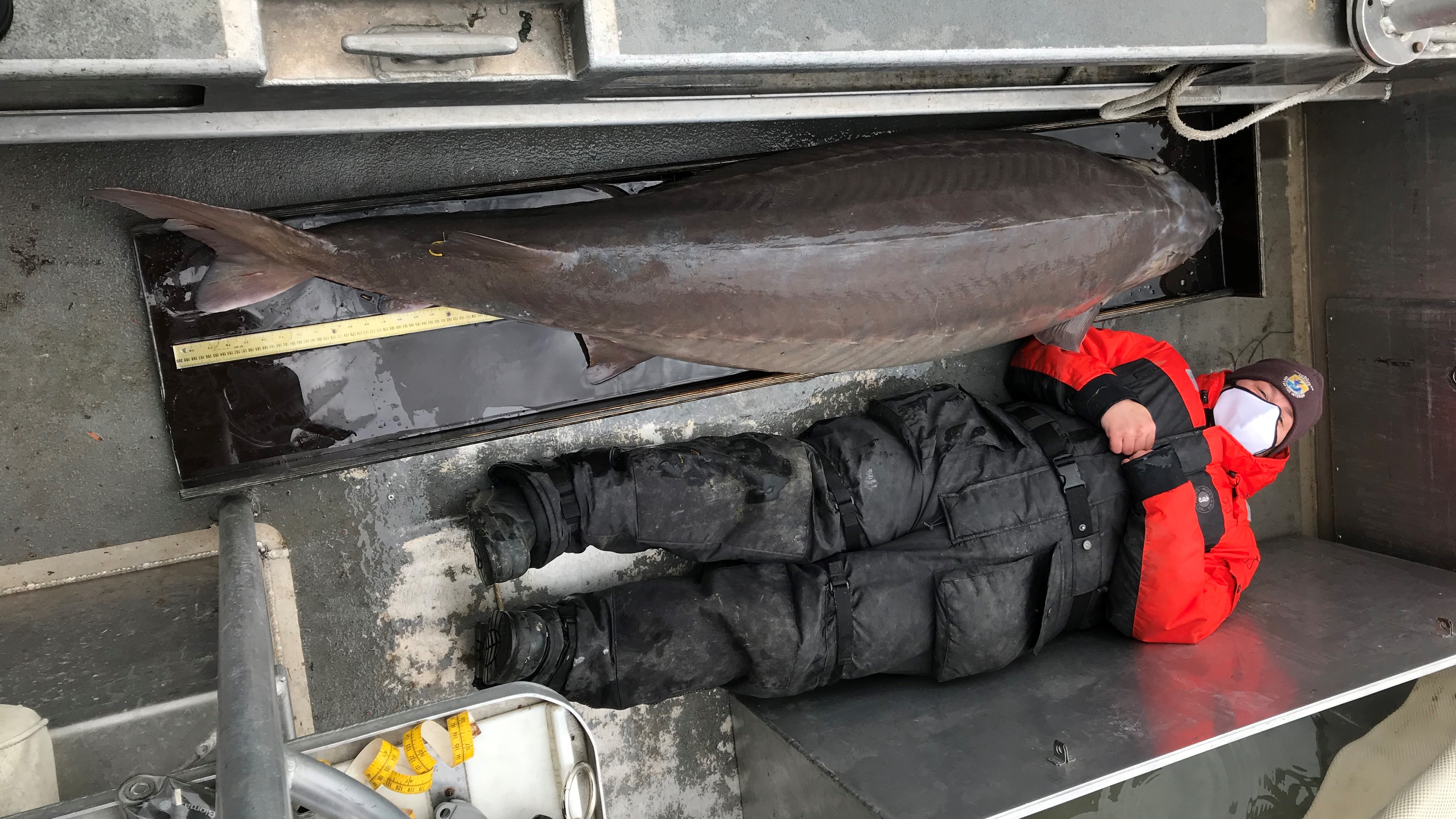7-foot 'monster' sturgeon found in Detroit River could be over 100 years old
It is one of the largest sturgeon ever caught in the U.S.

Biologists just captured a scale-tipping 240-pound (109 kilograms) sturgeon measuring 6 feet 10 inches (2.1 meters) in length in the Detroit River in Michigan. The enormous fish, which is likely a female and could be more than 100 years old, is believed to be one of the largest of its kind ever caught in the U.S., according to the U.S. Fish and Wildlife Service (USFWS).
The researchers were surveying lake sturgeon in the area on April 22 when they caught the supersized sturgeon. It took three people to haul in, measure and tag the fish, which was later released back into the river. The biologists, from the Alpena Fish and Wildlife Conservation Office (AFWCO), were shocked by the discovery and described the sturgeon as a "real-life river monster," according to CNN.
"As we pulled it in, it just got bigger and bigger," Jason Fischer, a fish biologist at the AFWCO who was involved in catching the sturgeon, told Live Science. "It ended up being over double the size of any fish caught in the area before, our excitement was through the roof."
Related: Photos of the largest fish on Earth
It was hard for the team to determine the fish's sex or age in the short window of time they had to assess it; but its size suggests the sturgeon is a female that is likely to be more than 100 years old. Incredibly, she had managed to avoid detection by scientific surveys in the area for over 20 years, Fischer said.
Gentle giants
Lake sturgeon (Acipenser fulvescens) are found in freshwater systems across the U.S., from the Hudson Bay to the Mississippi River. Males can live for 50 to 60 years, but the females are believed to have life spans that exceed 100 years, and as a result they can grow to be much larger, according to the USFWS.
Sturgeon look very similar to their prehistoric ancestors and have a distinct shark-like tail and rows of armored plates called “scutes” for protection. These characteristics, combined with their large size, give the fish their monstrous appearance; but they are actually completely harmless to humans.
Sign up for the Live Science daily newsletter now
Get the world’s most fascinating discoveries delivered straight to your inbox.
Sturgeon are bottom-feeders and spend most of their time at the bottoms of rivers and lakes, where they feed on insects, worms, snails, crayfish and small fish. They catch their prey via suction feeding — by sucking down large amounts of prey-filled water and sediment — and as a result, they do not have any teeth.
Related: Photos: The freakiest-looking fish on the planet
Lake sturgeon are also very popular among local residents of the Detroit River area. "They are a large, charismatic fish, and a lot of people enjoy seeing them and knowing they are out there," Fischer said.
Under threat
Lake sturgeon are currently listed as threatened in 19 of the 20 states they are found in, including Michigan, according to the USFWS. There are a number of reasons for this, including toxic pollution in waterways and the construction of dams and flood-control measures that impact their ability to travel upstream to their spawning grounds. However, one of the main factors was historic overfishing.
"About 120 years ago, there was a very strong commercial fishery for sturgeon across the U.S.," Justin Chiotti, a fish biologist at the AFWCO who was not involved in catching the sturgeon, told Live Science. "A lot of the big fish got taken out."
Since then, other pressures, such as pollution, have decreased the life expectancy of the sturgeon, which makes the size of this particular fish even more impressive, Chiotti said.
There are now bans on commercial fishing and strict catch limits in place for recreational fishing for sturgeon, which are starting to show signs of recovery, Fischer said. The Detroit River now has one of the healthiest populations in the country, with more than 6,500 lake sturgeon, Chiotti said.
The surveys carried out by AFWCO and other USFWS groups across the country play an important role in monitoring population recovery, and supersized individuals like this one are indicators that the population and wider ecosystem are doing well, Chiotti said.
However, the scientists think there may still be bigger fish lurking in the depths.
"I don't think we caught the biggest sturgeon in the system," Chiotti said. "There are historical accounts of even larger fish being found."
Originally published on Live Science.

Harry is a U.K.-based senior staff writer at Live Science. He studied marine biology at the University of Exeter before training to become a journalist. He covers a wide range of topics including space exploration, planetary science, space weather, climate change, animal behavior and paleontology. His recent work on the solar maximum won "best space submission" at the 2024 Aerospace Media Awards and was shortlisted in the "top scoop" category at the NCTJ Awards for Excellence in 2023. He also writes Live Science's weekly Earth from space series.









